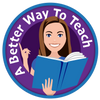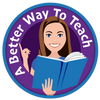Semicolon vs. colon: which one do you use and when and why? This question probably keeps you up in those wee hours of the night, but no need to lose any more sleep. We can sort this whole thing out, plus how to teach these concepts to your students in a way that does not absolutely bore them to tears.
Put on your seat belts, and let's go!

Let’s jump into the difference between these two symbols because frankly they look quite similar (so many dots), and frankly they are pretty similar in usage. But they do contain some fun, subtle differences.
But first, your students need to know some basics before you teach semicolons and colons. Grab this free parts of speech unit if your students need a refresher before you jump into this lesson.
Let’s first look at when a writer would use a semicolon. You use a semicolon when you are:
- Joining two independent clauses, but you don’t want to separate them with a period.
- Example: Steve Harvey is the best game show host of all time; he's gorgeous and hilarious.
- Joining two independent clauses when the second clause starts with a conjunctive adverb or a transition (this is just a more detailed explanation of that first rule).
- Example: I adore guitar music; however, I’m not a fan of the ukulele.
- Joining elements in a series when the items in the series already have a commas.
- Example: The most amazing places I’ve been to include Kathmandu, Nepal; Paris, France; and Truth or Consequences, New Mexico.
Those are the main uses for the semicolon. Pretty straightforward right? Heck yeah! Let’s keep going.
The colon is a bit different, but similar in a few ways. You use a colon when you are:
- Listing several items and the words before the list could be a complete sentence.
- I bring the following to class every day: a pen, a paper, and a willing spirit.
- To stand in for a phrase like "they were" or "it is."
- Juan had mesmerizing eyes: blue with a hint of a troubled past.
- Joining two independent clauses when you want to emphasize the second clause.
- I made it just in time: the Sasquatch didn't hear me.
Why It’s Important To Know How To Use Semicolons and Colons
Semicolons and colons may not be the most important thing you teach to your secondary students, but there is still a great deal of value in knowing punctuation rules and using punctuation correctly.
I like to think of punctuation as similar to having a clean or messy house.
See, if you have a clean house, people don't really notice. They just come on in, have a seat in a cozy chair, and start chatting with you about books. They enjoy you. They enjoy your company.
But if your house is messy--if your dishes are piled high, and there's a stench of rotten chicken floating from the trash--well, people notice. Their cup of tea is not quite as yummy when they have to breath through their mouth because the smell of rotten chicken is wafting through the air.
Ok, on the real. My house is a mess right now (we are moving back in after mold problems). So, I am in no way judging you if your house is messy. But stick with me.
Punctuation is like this.
If you (or your students) don't have punctuation errors, then nobody notices. Instead, the reader gets comfy and enjoys the content of their writing.

But if the writer has punctuation problems, then the reader does notice. They notice that misplaced apostrophe or that run on. And they have to slow down and figure stuff out. This distracts the reader from the content of what the writer is saying.
So, it’s critical to avoid errors with colons and semicolons; it’s also great to use colons and semicolons purposefully. When students can use these well they have another tool for better writing. And the more tools students have, the more they can write with voice. Their voice will set their writing apart. And that’s pretty great.

How To Teach Semicolons
Now that I’ve thoroughly convinced you to teach semicolons, I’m going to walk you through the process of how to to do it, so that your students pay attention and then actually use them in their writing.
You Have To Give (Some) Direct Instruction
Most students rarely (if ever) use a semicolon in their writing. So you do have to tell them directly. Give them the three main uses for using semicolons and give them some fun examples that showcase when they can use a semicolon.
I find it effective to include some humor in your example sentences and drop some relevant pop culture references in there if you can pull that off without looking too cheesy.
Here’s an example:

Showcase how semicolons are used with mentor sentences
After laying out the uses of a semicolon, direct students’ attention to how semicolons come up in the literature we read. You can do this through finding mentor sentences that use a semicolon. I love this one that uses 3 (count ‘em) semicolons in a super short sentence.

When using mentor sentences you can have your students discuss what’s going on in terms of why the author might have made this choice. Why would the author use a semicolon instead of breaking the sentence into 2 sentences (using a period to separate the clauses)? How might it change the rhythm or cadence if a semicolon is used instead of a period?
This is fun stuff, right?!
Ok, maybe your students will get into the mentor sentences, and maybe not so much.
That’s why I like to wrap up most grammar lessons with a short clip and have students write about it using the concept we’ve discussed. I suggest clips that are anywhere from 2 minutes to 7 minutes. You can check out a few of my short clip suggestions here, and I also include a link to a clip or short film in all my lessons.
After students watch the clip, have them summarize what happens in it in a few sentences, but here’s the key…you gotta use a semicolon somewhere! Then have them highlight that sentence.
I do include a few more fun strategies in my lesson on semicolons that keep students engaged from the beginning of class until the end of class. If you want to grab my bundle that includes this lesson, my colons lesson, quick write practice prompts, and a short quiz, get all of that here.
How To Teach Colons
You can teach colons with a similar approach to teaching semicolons: use direct instruction, mentor sentences, and fun writing prompts so students can practice the concept in their own writing.
One thing that is worth emphasizing is that a colon can be quite powerful. When we put a colon in a sentence, it directs the reader’s mind to that second clause. It is essentially saying “heads up, take a look at this.”
So when a student learns how to use a colon, they can truly add more voice to their writing which will separate their writing from others’ writing, and it causes their reader to pay more attention to what they are saying--their content.
Here’s my schtick: great writing opens doors. When students can write well, they will have more opportunities. So, as teachers, it's critical to give them the tools they need to become better writers with a louder voice. Who’s with me?!

In addition to using mentor sentences, scaffolding, and fantastic prompts, it’s also necessary to follow up, so give your students chances to practice this concept. That’s why I suggest giving students quick write prompts where they can use semicolons and colons again in their writing.
These quick writes are 5-10 minute writing assignments where students get to write about themselves. The prompts are straightforward and fun, and they only have to write about one. In their writing they need to use a colon or a semicolon somewhere. You can see a few of the types of prompts I like to use here.
Additional practice is a key part of allowing grammar concepts to sink in; this is what takes students from getting the concept on a surface level to actually using it in their own writing. It’s definitely worth the 10 minutes to do this as a bell ringer the day after you teach the lesson.

Feeling a bit....overworked?
Teachers are overworked; let's face facts. You don’t have a few hours to find mentor sentences that highlight colon usage. That’s why I’ve gone ahead and put together a lesson on semicolons, a lesson on colons, quick writes for both, and even a quiz that showcases mentor sentences. Bonus: I also include a video tutorial where I walk you through both lessons and exactly how to teach them to your students.
You can grab the whole bundle here or you can get instant access to these lessons and over 100 more resources when you join the English Teacher Vault (find out more about that here).
Takeaways
- If students know how to punctuate correctly, the reader will not be distracted by errors.
- When students know how to use semicolons and colons well they have another tool for powerful writing.
- Using colons and semicolons allows students to write with more voice which sets their writing apart.
Related Reading
Shop This Post








Leave a comment